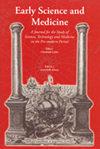成员的肤色,身体的肤色,中世纪晚期学术医学
IF 0.5
2区 哲学
Q3 HISTORY & PHILOSOPHY OF SCIENCE
引用次数: 0
摘要
根据中世纪的医学理论,每个人的整个身体都有一个大致的肤色,但同时,每个器官都有一个特定的肤色,这是由它的解剖结构、功能,当然还有个人决定的。因此,这两种肤色之间的关系问题对医生来说是至关重要的:身体肤色的变化会对单个器官产生影响吗?一个成员肤色的改变会改变整个身体的整体功能吗?不同器官的不同肤色之间的相互作用是什么?所有这些问题,在盖伦的《泰尼》一书中只是简单地解决了一下,但在13世纪末,医生们开始系统地解决这些问题。一些思想家开始写关于这个主题的专门论文,通常被称为De resistentiis,处理他们之间特定情况的“抵抗”(或“反操作”)。本文讨论了这场辩论的起源,强调了外邦人的作用(1348年),并展示了讨论在接下来的一个世纪中是如何演变的。因此,其目的是在提出对科学问题产生的方式和如何演变的反思的同时,提出一个被忽视的关于肤色的医学辩论。本文章由计算机程序翻译,如有差异,请以英文原文为准。
Complexion of the Members, Complexion of the Body, in Late-Medieval Scholastic Medicine
According to the medical theory of the Middle Ages, every individual had a general complexion for its whole body, but at the same time each organ had a specific complexion, determined by its anatomy, its function, and, of course, the individual. The problem of the relationship between those two types of complexion was, therefore, crucial for the medical practitioner: could a shift in the complexion of the body have an effect on a single organ? Could a change in the complexion of one member alter the general functioning of the body? And what were the interactions between the separate complexions of the various organs? All these questions, which had only briefly been tackled by Galen in his Tegni , began to be systematically addressed by physicians at the end of the thirteenth century. Some thinkers started to write specific treatises on the subject, often called De resistentiis , dealing with the “resistance” (or “counter-operations”) of particular complexions between them. The present paper deals with the origins of this debate, highlighting the role of Gentile da Foligno (d. 1348), and shows how the discussion evolved in the following century. Thus, the aim is to present an overlooked medical debate on complexion while proposing a reflection on the way in which scientific problems can come into being and how they can evolve.
求助全文
通过发布文献求助,成功后即可免费获取论文全文。
去求助
来源期刊

Early Science and Medicine
HISTORY & PHILOSOPHY OF SCIENCE-
CiteScore
0.50
自引率
0.00%
发文量
22
审稿时长
>12 weeks
期刊介绍:
Early Science and Medicine (ESM) is a peer-reviewed international journal dedicated to the history of science, medicine and technology from the earliest times through to the end of the eighteenth century. The need to treat in a single journal all aspects of scientific activity and thought to the eighteenth century is due to two factors: to the continued importance of ancient sources throughout the Middle Ages and the early modern period, and to the comparably low degree of specialization and the high degree of disciplinary interdependence characterizing the period before the professionalization of science.
 求助内容:
求助内容: 应助结果提醒方式:
应助结果提醒方式:


